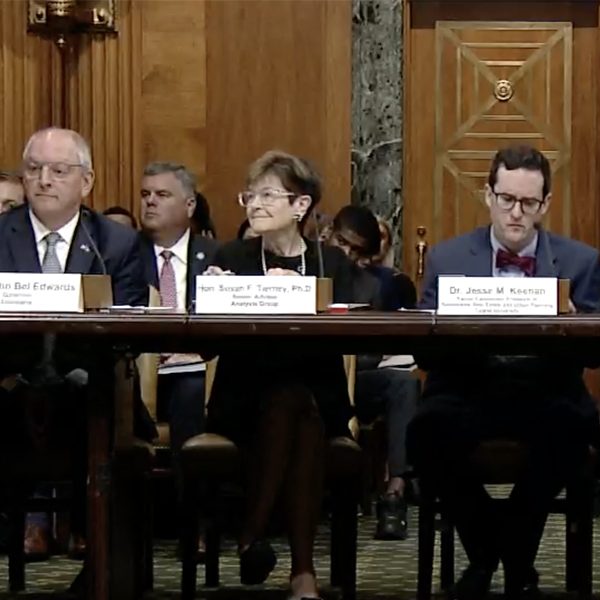
Climate change already is causing billions of dollars in economic costs and damage to infrastructure, including the power grid, the Senate Budget Committee heard at a hearing Wednesday.
“Our power grids are seeing record-breaking demand and reduced power efficiency, as well as added sea level rise risk where infrastructure — especially thermal power plants — is located along the coast,” said Committee Chair Sheldon Whitehouse (D-R.I.). “Extreme weather is responsible for 78% of the major disruptions to our power system. Since 2015, the frequency of major blackouts has doubled.”
During an average year, power outages can cost about $44 billion, but that can be doubled or more because of major climate impacts, he added.
Winter Storm Uri in February 2021 knocked out power to millions in Texas and surrounding states, leading to at least 246 deaths and damages ranging from $80 billion to $130 billion, said Analysis Group Senior Adviser Susan Tierney. In December, Winter Storm Elliott cut power to hundreds of thousands on the East Coast and knocked out a quarter of the generation in PJM (although the RTO kept the lights on in its territory). (See PJM Recounts Emergency Conditions, Actions in Elliott Report.)
“Before it could no longer do so, PJM had been exporting power to neighboring utilities in the Tennessee Valley Authority region and the Carolinas where rolling blackouts were underway,” Tierney said in written testimony.
Extreme heat and drought also have tested the energy systems, as have wildfires, hurricanes and other events.
“Due to the changing climate, the energy system is projected to be increasingly threatened by more frequent, longer-lasting power outages affecting critical energy infrastructure and creating fuel shortages,” she added.
Hurricane Katrina in 2005 showed what could happen when a major storm wreaks havoc on key energy infrastructure — cutting one-third of domestic oil production and one-sixth of natural gas production.
“U.S. oil and gas prices were double the national average for months and it raised the national cost of natural gas on the order of $50 billion in the 10 months after the storm,” said Tierney.
That hurricane led to a major policy change in Louisiana, its first “Comprehensive Master Plan for a Sustainable Coast.” The plan, which has been updated three times since then, already has produced benefits, said Gov. John Bel Edwards (D).
“The Coastal Master Plan is a $50 billion, 50-year roadmap that prioritizes our investment in coastal infrastructure,” Edwards said. “The plan reflects the best available science, accounting for changes on the ground and forecasting what is at risk in the future.”
If the plan is properly implemented, Louisiana could have less at risk from sea rise and related storm risks in 50 years than it does today, he said. Without action, the state would lose thousands of square miles of coastline and increase its vulnerability to storms, he added.
After Katrina, the levees and other protections around New Orleans got a $14.5 billion upgrade. It did not fail during several hurricanes since and thus has saved billions in damages, Edwards said.
Next month marks the 20th anniversary of another major energy disruption — the East Coast Blackout, which left 50 million without power for up to two days in what was the most widespread blackout in North American history, said ITC Holdings CEO Linda Apsey.
“It was a sobering reminder of how vulnerable our nation’s energy security can be when we fail to adequately invest in transmission infrastructure,” Apsey said. “This event served as the impetus for regulators and energy providers to put safeguards in place that have made our grid more reliable and resilient than it was before.”
Although the industry has improved since then, the country needs to update how transmission is built to better secure the grid, Apsey said.
“Building transmission can take up to a decade, if not more — a pace nowhere near fast enough to meet the [Biden] administration’s clean energy goals,” Apsey said. “It’s imperative that we examine changes to ensure that investment in transmission is predictable, timely and cost-effective in order to realize the benefits of a modern transmission grid.”
Making it easier to build transmission lines so they do not get delayed by years of litigation and permitting disputes is going to be a key part of that effort, she added.
MISO’s Cardinal-Hickory Creek Line, which is planned to run 102 miles from Iowa to Wisconsin, was part of the original Multi-Value Projects (MVP) in 2011, but it has yet to be built due to permitting concerns over the 1.3 miles that crosses federal land, said Apsey. The courts recently cleared the way for federal permitting authorities to approve the project and ITC is ready to start work when they do.
“Over 100 renewable energy projects are awaiting completion of the Cardinal-Hickory project in order to interconnect to the grid, resulting in hundreds of millions of dollars in lost energy savings to customers,” Apsey said.

